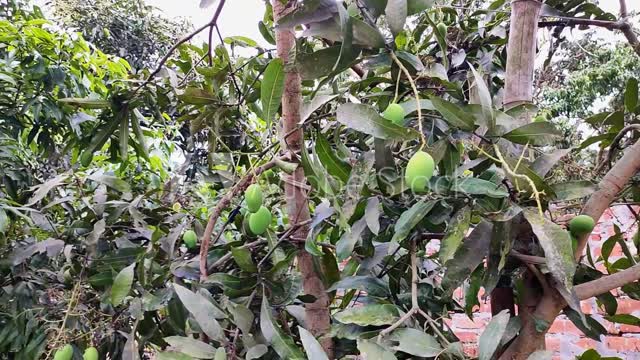Premium Only Content

One Indian Village, More Than 100 Varieties of Mangoes
Kannapuram locals are documenting and conserving the many kinds of their favourite fruit.
By Rashmi Gopal Rao JULY 27, 2022
A community mango event in Kannapuram. ALL PHOTOS COURTESY OF SHYJU MACHATHI
Some are as large as coconuts while others are as tiny as gooseberries. Some have the pleasant sweetness of cane sugar while others have the sharp tartness of tamarind. Some are bright red, others sport a dull pistachio hue. This is just a glimpse of the biodiversity of mango species found in the tiny village of Kannapuram, located in India’s Kannur district in the southern state of Kerala. The plethora of native mango varieties here is truly mind-boggling.
With 207 indigenous varieties and counting, it rains mangoes in Kannapuram. In fact, Kuruvakkavu, a small area within Kannapuram, boasts a whopping 102 varieties among 382 trees, growing on a plot of just 300 square meters (3,230 square feet). On July 22, 2020—World Mango Day—the Kerala State Biodiversity Board declared Kuruvakkavu an Indigenous Mango Heritage Area. All this is thanks to the efforts of about 20 local families, led by 42-year-old police officer Shyju Machathi.
Shyju Machathi is beside one of his community's many mango trees.
A resident of Kannapuram, Machathi nurtured a love for mangoes even as a child. Summer vacations meant climbing different mango trees, collecting the fruits and distributing them among family and neighbours. “During the mango season, eating, collecting, and distributing different varieties was my hobby,” he says. “It was a time when mangoes were not commercially available and we all ate whatever was available locally.”
Mahathir's parents cultivate rice, but he has no formal background in farming. His foray into mango variety conservation began in 2016 when a friend alerted him that a 200-year-old mango tree bearing the fruit of the rare, sweet “Vellatha'' variety was being cut down. “Even though I reached there only the next day along with a friend from the agricultural department, we were able to obtain close to 50 [cuttings] which we grafted and propagated successfully,” says Mahathir. Keeping just one for himself, he distributed the cuttings among the community so people could plant them and the variety could be preserved. Local news channels covered his mango rescue operation, which further inspired Machathi to identify and preserve other regional varieties.
The next year he collected and documented 36 indigenous mango varieties and, with the support of friends and officials from the agricultural department, organized an event highlighting the wealth of the indigenous species in the area. It was the first of many mango events to come and motivated locals to support Machathi in his efforts. “It was indeed a surprise for us to discover so many varieties in our own backyard,” says Jeyachandran, who has been helping Machathi collect and document varieties. “The best part is that each one has a unique taste and flavour.”
By 2020, and with the help of about 20 families, Machathi had identified more than 100 varieties by analyzing features such as colour, taste, the thickness of outer skin, fibre content, pulp characteristics, and the shape of the leaves. Before this, locals had no idea there were so many kinds of mangoes in Kannapuram.
About Us https://bit.ly/3GUPFOa +919942258153 kvk.subadhra@gmail.com
Thank You Very Much for Sharing YourValuable Thoughts
https://www.digistore24.com/redir/427920/CHUS87/
-
 LIVE
LIVE
Donut Operator
2 hours agoREADY OR NOT WITH BRANDON HERRERA AND MA SON
13,081 watching -
 LIVE
LIVE
The Mel K Show
4 hours agoMel K & Dr. Kirk Moore | A Doctor’s Oath: Doing What is Right No Matter the Cost | 7-26-25
358 watching -
 LIVE
LIVE
Mally_Mouse
3 hours agoSpicy Saturday!! - 10k CELEBRATION! - Let's Play: Labyrinthine
407 watching -
 36:44
36:44
NordicVentures
5 days ago $0.03 earnedWINTER Bushcraft 2 Nights: Building ALONE a Survival Shelter
19 -
 53:25
53:25
SouthernbelleReacts
4 days agoMy Reaction to 12 Monkeys (1995) | Time Travel, Madness & Bruce Willis Brilliance
741 -
 9:04
9:04
Blackstone Griddles
1 day agoDouble Western Smashburgers on the Blackstone Griddle
6101 -
 3:30:54
3:30:54
Barry Cunningham
6 hours agoTULSI GABBARD AND DAN BONGINO SOUND ALARMS! CNN MISREADS EPSTEIN EFFECT! AND MORE!
116K89 -
 22:09
22:09
MYLUNCHBREAK CHANNEL PAGE
10 hours agoThe 5 Eyes Are Watching You - Pt 1
23.2K34 -
 LIVE
LIVE
Spartan
4 hours agoSpartan - Pro Halo Player for OMiT | Scrims vs Tenrai then ranked (probably)
223 watching -
 10:12
10:12
WhaddoYouMeme
1 day ago $0.08 earnedHe Calculated the End—and Says It’s Almost Here
1.67K9